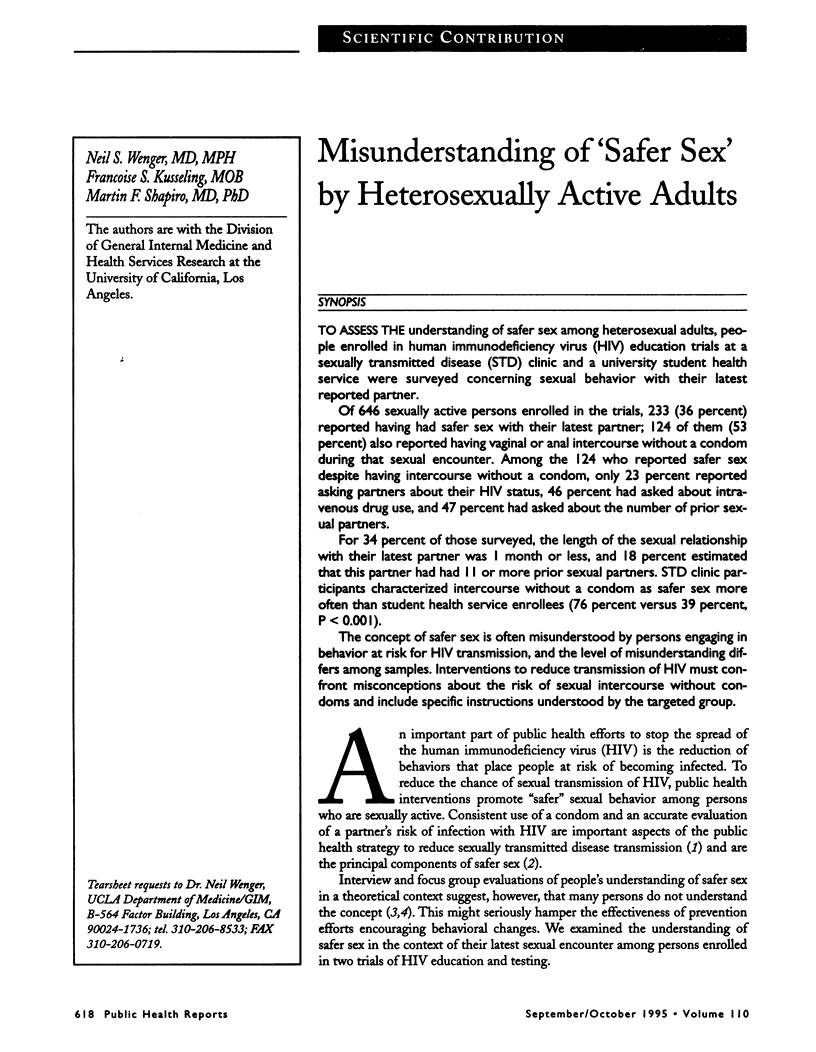Abstract
To assess the understanding of safer sex among heterosexual adults, people enrolled in human immunodeficiency virus (HIV) education trials at a sexually transmitted disease (STD) clinic and a university student health service were surveyed concerning sexual behavior with their latest reported partner. Of 646 sexually active persons enrolled in the trials, 233 (36 percent) reported having had safer sex with their latest partner; 124 of them (53 percent) also reported having vaginal or anal intercourse without a condom during that sexual encounter. Among the 124 who reported safer sex despite having intercourse without a condom, only 23 percent reported asking partners about their HIV status, 46 percent had asked about intravenous drug use, and 47 percent had asked about the number of prior sexual partners. For 34 percent of those surveyed, the length of the sexual relationship with their latest partner was 1 month or less, and 18 percent estimated that this partner had had 11 or more prior sexual partners. STD clinic participants characterized intercourse without a condom as safer sex more often than student health service enrollees (76 percent versus 39 percent, P < 0.001). The concept of safer sex is often misunderstood by persons engaging in behavior at risk for HIV transmission, and the level of misunderstanding differs among samples. Interventions to reduce transmission of HIV must confront misconceptions about the risk of sexual intercourse without condoms and include specific instructions understood by the targeted group.
Full text
PDF



Selected References
These references are in PubMed. This may not be the complete list of references from this article.
- Campostrini S., McQueen D. V. Sexual behavior and exposure to HIV infection: estimates from a general-population risk index. Am J Public Health. 1993 Aug;83(8):1139–1143. doi: 10.2105/ajph.83.8.1139. [DOI] [PMC free article] [PubMed] [Google Scholar]
- Davies P. M. Safer sex maintenance among gay men: are we moving in the right direction? AIDS. 1993 Feb;7(2):279–280. [PubMed] [Google Scholar]
- Goedert J. J. What is safe sex? Suggested standards linked to testing for human immunodeficiency virus. N Engl J Med. 1987 May 21;316(21):1339–1342. doi: 10.1056/NEJM198705213162111. [DOI] [PubMed] [Google Scholar]
- Macintyre S., West P. 'What does the phrase "safer sex" mean to you?' Understanding among Glaswegian 18-year-olds in 1990. AIDS. 1993 Jan;7(1):121–125. doi: 10.1097/00002030-199301000-00019. [DOI] [PubMed] [Google Scholar]
- Weiss S. H., Weston C. B., Quirinale J. Safe sex? Misconceptions, gender differences and barriers among injection drug users: a focus group approach. AIDS Educ Prev. 1993 Winter;5(4):279–293. [PubMed] [Google Scholar]
- Wenger N. S., Greenberg J. M., Hilborne L. H., Kusseling F., Mangotich M., Shapiro M. F. Effect of HIV antibody testing and AIDS education on communication about HIV risk and sexual behavior. A randomized, controlled trial in college students. Ann Intern Med. 1992 Dec 1;117(11):905–911. doi: 10.7326/0003-4819-117-11-905. [DOI] [PubMed] [Google Scholar]
- Wenger N. S., Linn L. S., Epstein M., Shapiro M. F. Reduction of high-risk sexual behavior among heterosexuals undergoing HIV antibody testing: a randomized clinical trial. Am J Public Health. 1991 Dec;81(12):1580–1585. doi: 10.2105/ajph.81.12.1580. [DOI] [PMC free article] [PubMed] [Google Scholar]


